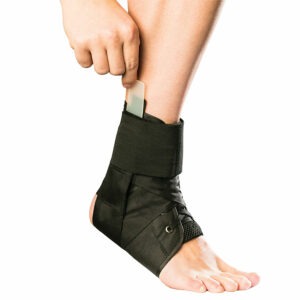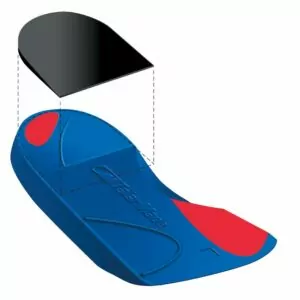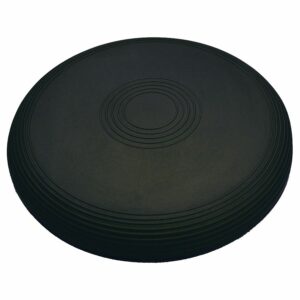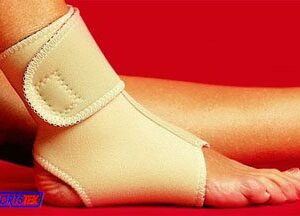Dislocated Ankle
Updated:
(Also known as Ankle Dislocation)
What is a dislocated ankle?
A dislocated ankle is a condition characterized by damage and tearing of the connective tissue surrounding the ankle joint with subsequent displacement of the bones forming the joint so they are no longer situated next to each other.
The lower leg comprises of 2 long bones, known as the fibula and the tibia, which are situated beside each other (figure 1). These bones join with each other and the talus to form the ankle joint (figure 1). The ankle joint comprises of strong connective tissue surrounding the joint known as the joint capsule and several ligaments providing additional stability. Numerous muscles around the ankle provide additional support.
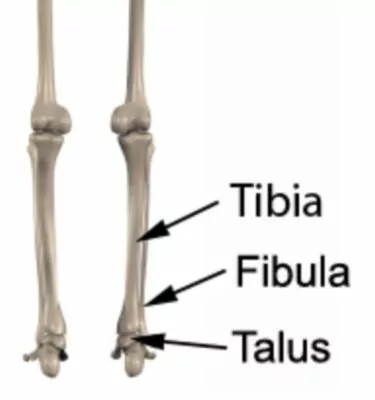
During certain movements of the ankle, stretching forces are applied to the ankle joint capsule. When these forces are excessive and beyond what the ankle can withstand, tearing of the connective tissue may occur. This may allow the ankle bones to move out of their normal position if the forces involved are too great and beyond what the connective tissue and supporting muscles can withstand. When this occurs, the condition is known as a dislocated ankle.
Due to the large forces required to dislocate the ankle, this condition usually occurs in combination with other injuries of the foot, ankle or lower leg such as fractures or severe (Grade III) ankle sprains.
Causes of a dislocated ankle
A dislocated ankle typically occurs traumatically due to forces pushing the ankle bones apart. This may occur due to a direct impact, motor vehicle accident or more commonly, due to a severe ankle sprain whereby the ankle is rolled excessively. Ankle dislocations are occasionally seen in sports requiring rapid changes of direction such as rugby, soccer, basketball, netball and football. The usual mechanism of injury is an extreme combination of pointing the foot and ankle downwards (plantarflexion – figure 2) whilst turning the foot either inwards (inversion – figure 3) or outwards (eversion – figure 4) excessively during weight bearing.
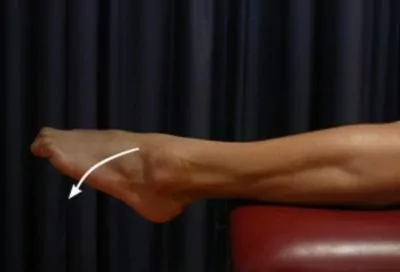
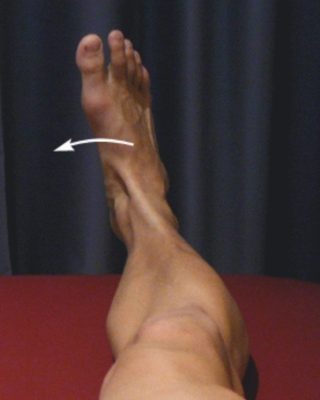
Figure 3 – Inversion
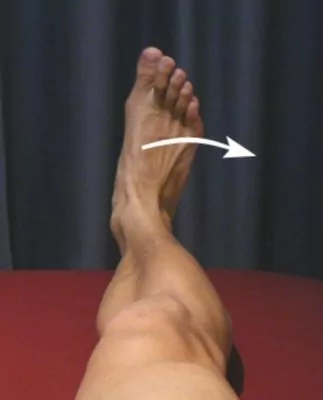
Figure 4 – Eversion
Signs and symptoms of a dislocated ankle
Patients with a dislocated ankle usually experience sudden severe pain at the time of injury. The pain is usually so intense that the patient cannot continue activity and will limp or be unable to weight bear at all. Pain is usually felt in the ankle region, however can occasionally radiate into the foot, lower leg or calf.
Patients with this condition will often experience a sensation of the ankle ‘moving out’ at the time of injury. Swelling and a visible deformity of the ankle may be detected when compared to the other side along with bruising which may become more visible over time. Pain will usually increase on firmly touching the affected region of the ankle joint. Loss of ankle movement is usually experienced which may worsen over the coming days as swelling increases. Occasionally, patients may experience pins and needles or numbness in the ankle, foot or toes.
Once a dislocated ankle has been ‘relocated’ (i.e. the bones put back into their normal position by a sports medicine professional or orthopaedic specialist), patients may experience a feeling of weakness in the ankle and an ache that may increase to a sharper pain with certain movements. These symptoms generally resolve over time with appropriate rehabilitation. However patients with this condition may be left with a feeling of impending dislocation when the ankle is placed in certain positions.
Diagnosis of a dislocated ankle
A thorough subjective and objective examination from a physiotherapist may be sufficient to diagnose a dislocated ankle. All ankle dislocations should be X-rayed to confirm diagnosis, assess the severity and rule out other injuries (particularly fractures). Further investigations such as an MRI or CT scan may be required to assist with diagnosis and assess the severity of the injury.
Treatment for a dislocated ankle
Before commencing treatment for a dislocated ankle, patients with this condition should have ankle X-rays to determine if there are any fractures associated with the dislocation. This is particularly important in the case of traumatic ankle dislocation where large forces are involved and should ideally occur before attempting to ‘relocate’ the ankle bones. Following X-ray an experienced sports medicine professional or orthopaedic specialist can assist with safely ‘relocating’ the ankle bones into their original position. This should not be attempted alone, as serious long term damage may occur to other structures around the ankle such as nerves, blood vessels, bones, ligaments and cartilage if the ankle relocation is performed incorrectly.
A review with an orthopaedic specialist is essential to ensure optimal management, particularly in the case of a dislocated ankle with associated fractures. Treatment may involve anatomical reduction of any displaced fractures (i.e. re-alignment of the fracture by careful manipulation under anaesthetic), surgical internal or external fixation to stabilize the ankle or fracture (e.g. using plates and screws), the use a protective boot, brace, plaster cast and/or crutches for a number of weeks. The orthopaedic specialist will determine the most suitable treatment based on a number of factors including the severity of injury and any associated fractures.
Following relocation of the ankle and appropriate orthopaedic specialist treatment of any associated injuries (e.g. fractures), all patients should undergo an intensive physiotherapy rehabilitation program. The success rate of treatment is largely dictated by patient compliance. Treatment for a dislocated ankle usually entails an initial period of immobilization for a number of weeks (e.g. in a plaster cast or protective boot) to allow the damaged connective tissue to heal and form a ‘scar’. During this period of immobilization, gentle exercises are often allowed as guided by the orthopaedic specialist and physiotherapist.
Physiotherapy treatment and appropriate rehabilitation for a dislocated ankle can begin once the orthopaedic specialist has indicated that it is safe to do so. One of the most important components of rehabilitation is that the patient rests sufficiently from any activity that increases their pain (crutches and / or a protective boot are often required). Activities which place large amounts of stress through the ankle should also be avoided, particularly excessive weight bearing activity such as running, jumping, standing or walking excessively (especially up hills or on uneven surfaces). Rest from aggravating activities allows the healing process to take place in the absence of further damage. Once the patient can perform these activities pain free, a gradual return to these activities and weight bearing forces is indicated provided there is no increase in symptoms. This should take place over a period of weeks to months (depending on the severity of injury) with direction from the treating physiotherapist and orthopaedic specialist.
Ignoring symptoms or adopting a ‘no pain, no gain’ attitude is likely to cause further damage and may slow healing or prevent healing altogether.
Patients with a dislocated ankle usually benefit from following the R.I.C.E. Regime. The R.I.C.E regime is beneficial in the initial phase of the injury (first 72 hours) or when inflammatory signs are present (i.e. morning pain or pain with rest). This should involve resting from aggravating activities (i.e. use of crutches, a protective boot or brace), regular icing, the use of a compression bandage and keeping the ankle elevated. Heat, alcohol and massage should also be avoided in the initial 72 hour period following injury or when inflammatory signs are present. Anti-inflammatory medication may also benefit those with a dislocated ankle by reducing the pain and swelling associated with inflammation.
Patients with a dislocated ankle should perform pain-free flexibility, strengthening and balance exercises as part of their rehabilitation to ensure an optimal outcome. Hydrotherapy exercises may also be recommended. This is particularly important, as balance, soft tissue flexibility and strength are quickly lost with inactivity. The treating physiotherapist can advise which exercises are most appropriate for the patient and when they should be commenced.
Manual “Hands-on” Therapy from the physiotherapist such as massage, mobilization, dry needling, stretches and electrotherapy can also assist with improving ankle range of movement and function following a dislocated ankle. This can generally commence once the orthopaedic specialist or physiotherapist has indicated it is safe to do so.
In the final stages of rehabilitation for a dislocated ankle, a gradual return to activity or sport can occur as guided by the treating physiotherapist provided there is no increase in symptoms.
It may be advised upon returning to some sports, particularly those sports requiring rapid change of direction, such as football and netball, that the ankle is either taped or braced for additional support or protection. The treating physiotherapist can advise if this is recommended.
Prognosis of a dislocated ankle
Many patients with a dislocated ankle heal well with appropriate physiotherapy and return to normal function. This may take weeks to months to achieve an optimal outcome. However, due to the severity of injury and widespread connective tissue damage associated with this condition, patients may experience long term effects. The most common long term effect of a dislocated ankle is an increased likelihood of future dislocation or ankle sprain with relatively minor trauma. In cases of recurrent ankle dislocation, surgical intervention may be indicated to increase the ankle’s stability. This is usually followed by an extensive rehabilitation program lasting many months.
Patients with a dislocated ankle who also have damage to other structures such as cartilage, bone or nerves are likely to have a significantly extended rehabilitation period to gain optimum function.
Contributing factors to the development of a dislocated ankle
There are several factors which can predispose patients to dislocating their ankle. These need to be assessed and where possible, corrected with direction from a physiotherapist. Some of these factors may include:
- history of a previously dislocated ankle or ankle instability
- inadequate rehabilitation following an ankle dislocation
- participation in sports or activities placing the ankle at risk of dislocation
- ankle weakness
- ankle joint hyper mobility
Physiotherapy for a dislocated ankle
Physiotherapy treatment is essential for all patients with a dislocated ankle as inadequate rehabilitation can result in a poor outcome with a high likelihood of re-injury. Physiotherapy can hasten the healing process, ensure an optimal outcome and reduce the likelihood of recurrence. Treatment may comprise:
- soft tissue massage
- electrotherapy (e.g. ultrasound)
- anti-inflammatory advice
- joint mobilization
- the use of crutches
- the use of heel wedges
- ankle taping
- ankle bracing
- ice or heat treatment
- exercises to improve flexibility, strength and balance
- hydrotherapy
- education
- activity modification advice
- biomechanical correction
- a gradual return to activity program
Other intervention for a dislocated ankle
Despite appropriate physiotherapy management, a small percentage of patients with a dislocated ankle do not improve adequately. When this occurs the treating physiotherapist or doctor can advise on the best course of management. This may involve further investigations such as an X-ray, CT scan or MRI, pharmaceutical intervention, corticosteroid injection or a review by a specialist who can advise on any procedures that may be appropriate to improve the condition. Surgical intervention may be indicated to repair the torn connective tissue or to correct other abnormalities associated with the dislocated ankle (such as fractures).
Exercises for a dislocated ankle
The following exercises are commonly prescribed to patients who are allowed to commence mobilization (as directed from their orthopaedic specialist) following an ankle dislocation. You should discuss the suitability of these exercises with your physiotherapist prior to beginning them. Generally, they should be performed 3 times daily and only provided they do not cause or increase symptoms.
Foot and Ankle Up and Down
Move your foot and ankle up and down as far as possible and comfortable without pain (figure 5). Repeat 10 – 20 times provided there is no increase in symptoms.
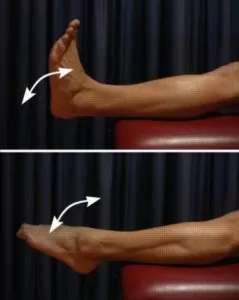
Foot and Ankle In and Out
Move your foot and ankle in and out as far as possible and comfortable without pain (figure 6). Repeat 10 -20 times provided there is no increase in symptoms.
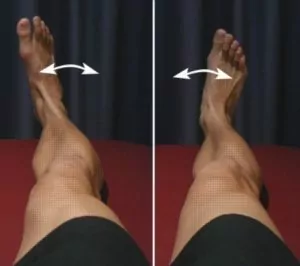
Find a Physio for a dislocated ankle
Find a Physiotherapist in your local area who can treat a dislocated ankle.
More information
- View more Ankle Stretches.
- View Ankle Strengthening Exercises.
- View Balance Exercises.
- View Ankle Taping Techniques.
- View our Ankle Diagnosis Guide.
Physiotherapy products for a dislocated ankle
Some of the most commonly recommended products by physiotherapists to hasten healing and speed recovery in patients with a dislocated ankle include:
To purchase physiotherapy products for a dislocated ankle click on one of the above links or visit the PhysioAdvisor Shop.

Link to this Page
If you would like to link to this article on your website, simply copy the code below and add it to your page:
<a href="https://physioadvisor.com.au/injuries/ankle/dislocated-ankle”>Dislocated Ankle – PhysioAdvisor.com</a><br/>PhysioAdvisor offers detailed physiotherapy information on a dislocated ankle including: symptoms, causes, diagnosis, treatment, exercises, physiotherapy products and more...
Return to the top of Dislocated Ankle.

